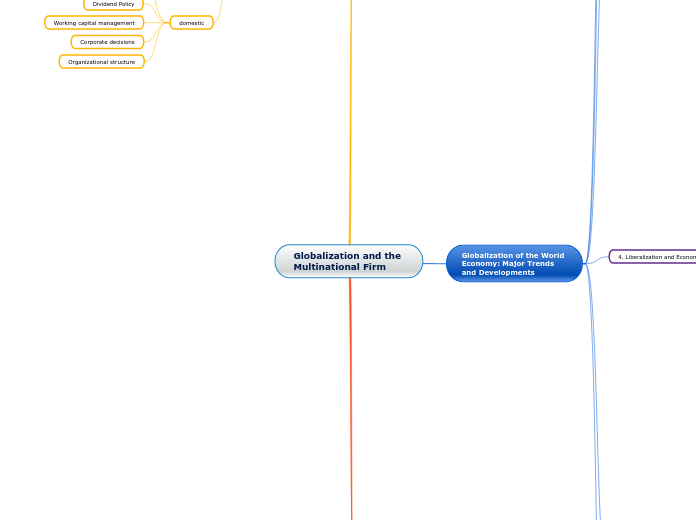Globalization and the Multinational Firm
Globalization of the World Economy: Major Trends
and Developments
1. Emergence of Globalized Financial Markets
1975 removed certain barriers
Fixed brokerage commissions
rapid integration of capital and financial markets
London Stock Exchange (LSE)
Foreign companies
Investment banking and commercial banking
2. Emergence of the Euro as a Global 1999
Creation of the European Central Bank (ECB)
Population terms
Economic production
Participation in world trade
Price stability
European finance changes
Government bonds
Shares of stock
Capital markets
Corporate bonds
More than 300 million Europeans in 17 countries
Fusions and acquisitions
Border alliances
3. Europe’s Sovereign Debt Crisis of 2010
Greek government deficit
Affection Ireland, Portugal and Spain
Cost Growth
Job drop
Production Drop
Wages drop
Investor resignation
Sell government bonds
Credit rating agencies
Loans and refinancing
Fall Standard & Poor's like Moody's
Indebtedness
Bad tax policy
expenses
Bad monetary policy
4. Liberalization and Economic Integration
Growth PIB
Free Market Policies
Exports
Market
Imports
Agreements
Customs Tariffs and Trade (GATT)
Reduction
Duty
Increase the proportion of free products
Extending the rules of world trade
Banking
Insurance
Import
Subsidies
Trade Barriers
Multilateral
North American Free Trade Agreement (NAFTA)
Free trade Area
World Trade Organization (WTO)
China joined
New free trade rules
Foreign investment
R&D functions
Barriers to free flow
Goods
People
Capitals
Quota system
Comparative advantage
Specialization in the production of more efficient goods
Trade those goods between countries
Trade liberalization
Mercantilist countries
Improve well-being
5. Privatization
The state is not involved
Free System
Make a hard coin
Efficiency
Reduce operating costs
Economic growth
International stock exchange
Business ventures
Business ownership among citizens
New capital for investments
6. Global Financial Crisis of 2008–2009
Lehman Brothers Bank went bankrupt
Serious credit crisis
Made loans more difficult
Confidence crisis in markets and institutions
Production fell
Unemployment increased
Stock prices fell
Refinancing
Factors
Indebtedness
Low liquidity
Taking excessive risks
They took too much risk
Expansion of the crisis
Invisible hands
Banking crisis
Interconnected and integrated international financial markets
They failed to self-regulate their excesses
Troubled Asset Relief Program (TARP)
Seven hundred billion were injected
Mortgage values
Buy delinquent assets
Financial Management
International
Market Liberation
International investments
Integration of financial markets
Market imperfections
Lack of information
restricts investment
Taxes
Barriers to trade
Expanded opportunity set
Resource maximization
Branch offices
Foreign exchange and political risks
Rules of the game of each country
domestic
Corporate objectives
Dividend Policy
Working capital management
Corporate decisions
Organizational structure
Multinational Corporations
Production and sales in many other countries
Produce goods with labor
Capital equipment in a third country
Opportunities
Reduce R&D expenses
Grouping global purchasing power over suppliers
Technological and management knowledge
Sell the finished product in other national markets
